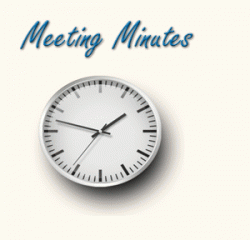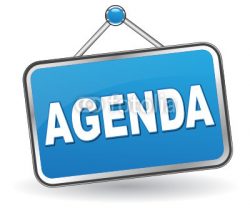Whether you’ve been tasked with taking notes for a committee or you’ve been appointed Secretary to your new Chama, preparing meeting minutes doesn’t have to be an arduous task.
 Why meeting minutes are important
Why meeting minutes are important
Minutes are a tangible record of the meeting for its participants and a source of information for members who were unable to attend. In some cases, meeting minutes can act as a reference point, for example:
- When a meeting’s outcomes impact other collaborative activities within the group.
- Minutes can serve to notify (or remind) individuals of tasks assigned to them and/or timelines.
- It is important to capture the essence of the meeting, including details such as:
Decisions made (motions made, votes, etc.)
Next steps planned
Identification and tracking of action items
Pre-planning
A well-planned meeting helps ensure effective meeting minutes. If the Chair and the Secretary or minutes-taker work together to ensure the agenda and meeting are well thought out, it makes minute taking much easier.
Meeting agenda = outline:
At the very least, it’s important to get a copy of the meeting agenda and use it as a guide or outline for taking notes and preparing the minutes – with the order and numbering of items on the minutes matching those of the agenda. In addition, the agenda and/or meeting notice also provides information that will need to be included in the minutes, such as:
- The names of all the meeting attendees
- Documents that are sent out with the agenda or handed out in the meeting – copies of handouts should be stored with the meeting minutes for future reference and for sharing with those who were unable to attend the meeting .
Clarifying Expectations
When you take on a new role as minutes-taker or Secretary, be sure to ask the Chair of the committee or Board what their expectations are of your role during the meeting, as well as the type of detail he/she expects in the minutes.
For example, if the group will be dealing with motions, or voting on items/issues, be clear on whether you need to offer names of those making motions, seconding, etc
Record taking – what should be included?
Before you start taking notes, it’s important to understand the type of information you need to record at the meeting. As noted earlier, your group may have required content and a specific format that you’ll need to follow, but generally, meeting minutes usually include the following:
- Names of the meeting participants and those unable to attend (e.g., “regrets”)
- Acceptance or corrections/amendments to previous meeting minutes
- Decisions made about each agenda item, for example:
• Actions taken or agreed to be taken
• Next steps
• Voting outcomes – e.g., (if necessary, details regarding who made motions; who seconded and approved or via show of hands, etc.)
• Motions taken or rejected
• Items to be held over
• New business
• Next meeting date and time
Tips that might help your note taking:
Create an outline
As discussed earlier, having an outline (or template) based on the agenda makes it easy for you to simply jot down notes, decisions, etc. under each item as you go along. If you are taking notes by hand, consider including space below each item on your outline for your hand-written notes, then print these out and use this to capture minutes.
Check-off attendees as they enter the room
If you know the meeting attendees, you can check them off as they arrive, or circulate an attendance list they can check-off themselves.
Record decisions or notes on action items in your outline as soon as they occur to be sure they are recorded accurately.
Ask for clarification if necessary
If the group moves on without making a decision or an obvious conclusion, ask for clarification of the decision and/or next steps involved.
Don’t try to capture it all
you can’t keep up if you try to write down the conversation verbatim, so be sure to simply (and clearly) write (or type) just the decisions, assignments, action steps, etc.
Record it
literally, if you are concerned about being able to keep up with note taking, consider recording the meeting (e.g. on a recording device) but be sure to let participants know they are being recording. While you don’t want to use the recording to create a word-for-word transcript of the meeting, the recording can come in handy if you need clarification.
The Minutes Writing Process
Once the meeting is over, it’s time to pull together your notes and write the minutes.
Try to write the minutes as soon after the meeting as possible while everything is fresh in your mind.
Review your outline and if necessary, add additional notes or clarify points raised.Also check to ensure all decisions, actions and motions are clearly noted.
When there is extensive deliberation before passing a motion, summarize the major arguments
Edit to ensure brevity and clarity, so the minutes are easy to read
• Be objective.
• Write in the same tense throughout
• Avoid using people’s names except for motions or seconds. This is a business document, not about who said what.
• Avoid inflammatory or personal observations.
Distributing or Sharing Meeting Minutes
As the official “minutes-taker” or Secretary, your role may include dissemination of the minutes. However, before you share these, be sure that the Chair has reviewed and either revised and/or approved the minutes for circulation.
Filing/Storage of Meeting Minutes
Most committees and Boards review and either approve or amend the minutes at the beginning of the subsequent meeting. Once you’ve made any required revisions, the minutes will then need to be stored for future reference. You may also need to print and store hard copies as well or provide these to a group member for storage purposes or Chair for filing.
In closing…enjoy your new role..
Meeting minutes are important – “they capture the essential information of a meeting.” But taking and preparing minutes doesn’t have to be a daunting task.
Categorised in: Chama minutes, Communication, General, Growing, Meetings
This post was written by
Please Subscribe and get Notified when new articles are posted
